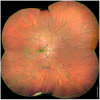Widefield and Ultra-Widefield Retinal Imaging: A Geometrical Analysis
- PMID: 36676151
- PMCID: PMC9867331
- DOI: 10.3390/life13010202
Widefield and Ultra-Widefield Retinal Imaging: A Geometrical Analysis
Abstract
Diabetic retinopathy (DR) often causes a wide range of lesions in the peripheral retina, which can be undetected when using a traditional fundus camera. Widefield (WF) and Ultra-Widefield (UWF) technologies aim to significantly expand the photographable retinal field. We conducted a geometrical analysis to assess the field of view (FOV) of WF and UWF imaging, comparing it to the angular extension of the retina. For this task, we shot WF images using the Zeiss Clarus 500 fundus camera (Carl Zeiss Meditec, Jena, Germany). Approximating the ocular bulb to an ideal sphere, the angular extension of the theoretically photographable retinal surface was 242 degrees. Performing one shot, centered on the macula, it was possible to photograph a retinal surface of ~570 mm2, with a FOV of 133 degrees. Performing four shots with automatic montage, we obtained a retinal surface area of ~1100 mm2 and an FOV of 200 degrees. Finally, performing six shots with semi-automatic montage, we obtained a retinal surface area of ~1400 mm2 and an FOV of 236.27 degrees, which is close to the entire surface of the retina. WF and UWF imaging allow the detailed visualization of the peripheral retina, with significant impact on the diagnosis and management of DR.
Keywords: diabetic retinopathy; field of view; imaging; retina; ultra-widefield; widefield.
Conflict of interest statement
The authors declare no conflict of interest.
Figures





Similar articles
-
ETDRS grading with CLARUS ultra-widefield images shows agreement with 7-fields colour fundus photography.BMC Ophthalmol. 2024 Sep 3;24(1):387. doi: 10.1186/s12886-024-03537-z. BMC Ophthalmol. 2024. PMID: 39227901 Free PMC article.
-
Comparison of widefield swept-source optical coherence tomography angiography with ultra-widefield colour fundus photography and fluorescein angiography for detection of lesions in diabetic retinopathy.Br J Ophthalmol. 2021 Apr;105(4):577-581. doi: 10.1136/bjophthalmol-2020-316245. Epub 2020 Jun 26. Br J Ophthalmol. 2021. PMID: 32591347 Free PMC article.
-
Comparison of quantitative assessment and efficiency of diabetic retinopathy diagnosis using ETDRS seven-field imaging and two ultra-widefield imaging.Eye (Lond). 2023 Dec;37(17):3558-3564. doi: 10.1038/s41433-023-02549-1. Epub 2023 Apr 29. Eye (Lond). 2023. PMID: 37120657 Free PMC article.
-
The Role of Ultra-Widefield Fundus Imaging and Fluorescein Angiography in Diagnosis and Treatment of Diabetic Retinopathy.Curr Diab Rep. 2021 Aug 27;21(9):30. doi: 10.1007/s11892-021-01398-0. Curr Diab Rep. 2021. PMID: 34448948 Review.
-
Ultra widefield fundus imaging for diabetic retinopathy.Curr Diab Rep. 2014 Aug;14(8):514. doi: 10.1007/s11892-014-0514-0. Curr Diab Rep. 2014. PMID: 24935049 Review.
Cited by
-
A Radiomic-Based Machine Learning System to Diagnose Age-Related Macular Degeneration from Ultra-Widefield Fundus Retinography.Diagnostics (Basel). 2023 Sep 15;13(18):2965. doi: 10.3390/diagnostics13182965. Diagnostics (Basel). 2023. PMID: 37761333 Free PMC article.
-
The role of ultra-widefield imaging with navigated central and peripheral cross-sectional and three-dimensional swept source optical coherence tomography in ophthalmology: Clinical applications.Saudi J Ophthalmol. 2024 Apr 23;38(2):101-111. doi: 10.4103/sjopt.sjopt_59_24. eCollection 2024 Apr-Jun. Saudi J Ophthalmol. 2024. PMID: 38988788 Free PMC article.
-
Utilizing fundus images captured by two ultra-wide field imaging systems to measure diagnostic indicators and assess the grade of diabetic retinopathy.BMC Ophthalmol. 2025 Feb 10;25(1):72. doi: 10.1186/s12886-024-03835-6. BMC Ophthalmol. 2025. PMID: 39930419 Free PMC article.
-
Axial elongation and the spatial distribution of white and dark without pressure in myopic eyes: insights from ultra-widefield imaging.BMC Ophthalmol. 2025 Apr 25;25(1):244. doi: 10.1186/s12886-025-04092-x. BMC Ophthalmol. 2025. PMID: 40281428 Free PMC article.
-
Measurement inaccuracies in widefield imaging-a cautionary tale.Graefes Arch Clin Exp Ophthalmol. 2024 Apr;262(4):1365-1367. doi: 10.1007/s00417-023-06356-y. Epub 2024 Jan 4. Graefes Arch Clin Exp Ophthalmol. 2024. PMID: 38175231 No abstract available.
References
LinkOut - more resources
Full Text Sources

